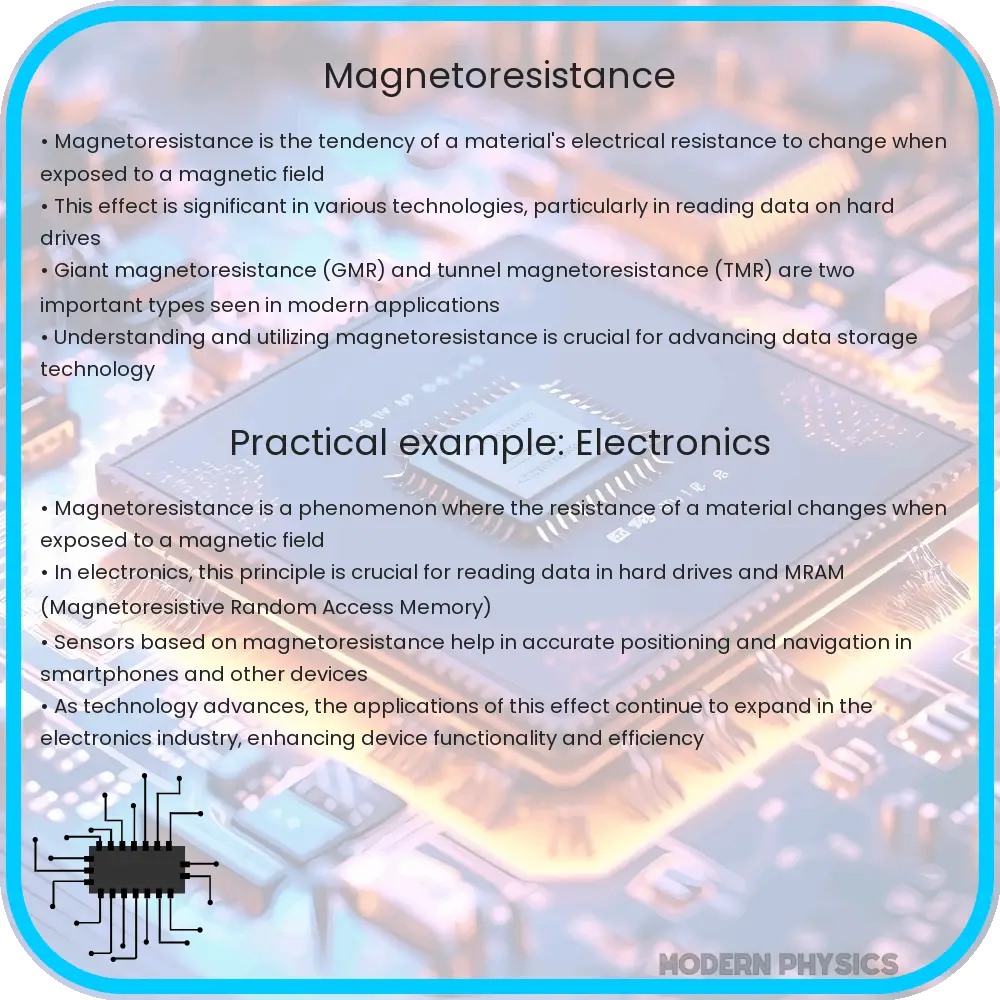Explore the principles, applications, and latest advances in Magnetoresistance (MR), a key technology shaping modern data storage and sensors.

Magnetoresistance: Unveiling the Marvels of Magnetic Influence on Electrical Resistance
Magnetoresistance (MR) is a fascinating phenomenon where the electrical resistance of a material changes in response to an applied magnetic field. This effect, first discovered in the 19th century, has since evolved into a cornerstone for modern data storage and sensor technologies. Understanding the principles of magnetoresistance not only paves the way for advanced technological applications but also offers intriguing insights into the interplay between magnetism and electrical conductance.
Principles of Magnetoresistance
The fundamental principle behind magnetoresistance lies in the interaction between magnetic fields and the motion of charge carriers, like electrons, in a material. When a magnetic field is applied to a conductive material, it can alter the trajectory of moving electrons. This deflection affects the material’s overall electrical resistance. The extent of this effect depends on the material’s properties, the strength of the magnetic field, and the angle of field application relative to the current.
Types of Magnetoresistance
- Anisotropic Magnetoresistance (AMR): Observed in ferromagnetic materials, AMR occurs when the resistance changes depending on the angle between the magnetic field and the direction of electrical current.
- Giant Magnetoresistance (GMR): A significant leap in MR technology, GMR is found in multilayered structures of alternating ferromagnetic and non-magnetic materials. The resistance dramatically decreases when the magnetic fields of adjacent layers align.
- Tunnel Magnetoresistance (TMR): This type involves two ferromagnetic layers separated by a thin insulating layer. Electrons can tunnel through this barrier, with the tunneling probability and thus resistance being dependent on the magnetic alignment of the layers.
Applications of Magnetoresistance
Magnetoresistance has a wide array of applications, particularly in data storage and magnetic sensing. In the realm of data storage, GMR and TMR effects are fundamental in the operation of hard disk drives (HDDs). The ability to detect small changes in magnetic fields allows for the high-density storage of data. Similarly, in magnetic sensing, MR sensors are crucial in various fields, from automotive to consumer electronics, providing precise measurements of magnetic fields.
Continued advancements in MR technology are driving innovations in various sectors. Emerging applications include magnetic random access memory (MRAM), which promises faster and more energy-efficient memory devices. Additionally, MR sensors are increasingly employed in biomedical applications, such as magnetic resonance imaging (MRI) and magnetic field-based diagnostics.
Advances in Magnetoresistance Technology
Recent breakthroughs in magnetoresistance technology have significantly broadened its scope and impact. One notable advancement is the development of Spintronics, where spin-based electronics utilize both the charge and spin of electrons. This innovation has led to more efficient and faster electronic devices, with spin-valve transistors being a prime example. Additionally, Colossal Magnetoresistance (CMR) materials have been identified, exhibiting a dramatic change in resistance under magnetic fields, opening new avenues for ultra-sensitive sensors and data storage technologies.
Another exciting development is in the field of Graphene-based magnetoresistance. Graphene, with its exceptional electrical and magnetic properties, has shown promising MR effects, leading to potential applications in next-generation electronic devices. Moreover, the miniaturization of MR sensors has facilitated their integration into microelectronic devices, greatly enhancing their functionality and scope of use.
Challenges and Future Directions
Despite its vast potential, magnetoresistance technology faces several challenges. Material stability and sensitivity to temperature variations remain significant hurdles, particularly for high-precision applications. Furthermore, the quest for materials exhibiting stronger MR effects at room temperature continues, as this would dramatically expand the technology’s practical applications.
The future of magnetoresistance technology seems poised for significant breakthroughs. Researchers are exploring new materials and nanostructures to enhance MR effects. The integration of MR technology with other emerging fields like quantum computing and nanotechnology could lead to revolutionary changes in electronics and data storage.
Conclusion
Magnetoresistance has come a long way from its initial discovery to becoming a pivotal component in modern technology. Its influence spans from data storage to advanced sensing applications, underpinning many of today’s technological conveniences. With ongoing research and development, magnetoresistance promises to be at the forefront of the next generation of technological innovations, offering more efficient, faster, and smarter electronic devices. As we continue to unlock the mysteries of magnetoresistance and harness its full potential, we edge closer to a future where the synergy between magnetic properties and electronic functionality reshapes our technological landscape.
